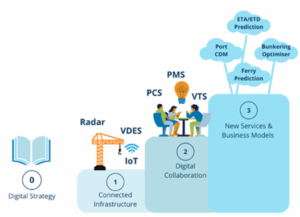CONSULTING
Innovation through open port ecosystems
Elisenda Ventura Jariod
Smart Ports Consultant | Linkedin
Ports and logistics hubs are going through a major digital transformation. As global trade becomes more complex and supply chains more interconnected, ports are evolving from traditional transport nodes into smart, data-driven environments. This shift is not just about adopting new technologies, it’s about rethinking how ports operate, collaborate, and create value.
The smart port: data as a driver for change
At the heart of this change is the idea of the smart port: digitally connected ecosystems where data flows smoothly between systems, stakeholders, and infrastructure. Technologies like the Internet of Things, artificial intelligence, digital twins, and blockchain are helping ports improve efficiency, reduce environmental impact, and coordinate operations more effectively. With these tools, ports can make faster decisions, predict issues before they happen, and automate key processes to stay competitive and safe.
Data is the key enabler of this new model. It allows ports to become more responsive, resilient, and valuable across the entire supply chain. But going digital is not just about installing new systems. It also means adopting a mindset that values innovation, openness, and collaboration across different sectors.
European initiatives and digital maturity models

UNCTAD maturity model for developing port digital maturity
Across Europe, a range of initiatives is helping ports move in this direction. These efforts generally fall into two categories: those focused specifically on the maritime and port sectors, and those that connect ports with broader digital innovation networks.
Sectoral models: the case of the Port of Seville
One example of a sector-specific initiative is the UNCTAD Port Digital Maturity Model. This framework helps ports understand where they are in their digital journey and what steps they need to take next. IDOM has adapted this model and uses it in its projects to assess digital maturity, set priorities, and guide ports toward becoming smart, data-driven hubs.
In the PRISMA project, developed at the Port of Seville, we are aligning technology investments with long-term goals. The project aims to enhance coordination and transparency across the port by deploying a Port Community System (PCS), a Port Management System (PMS), and other advanced digital tools. These systems will create a shared port data space that integrates information from various sources, such as sensors, IoT devices, and port operation systems. This integration will support a dynamic, data-driven model of the port’s infrastructure and operations. It will also improve collaboration among stakeholders, enabling smarter, more efficient, and sustainable port operations. As an added value, we are developing a sandbox environment. This is a controlled, real-world testing space where new digital services and data integrations can be safely trialed and validated.
Cross-sectoral innovation: the impetus of DOME and PaaSPort4.0
Sectoral innovation is advancing through collaborative research, pilot projects, and supportive policies. Initiatives like the European Maritime Single Window, the Just-In-Time Arrival guidelines, ICS2, and the eFTI regulation are driving standardization and integration in digital systems, enabling seamless data exchange across borders and sectors. Ports also benefit from engaging with broader digital ecosystems, such as the European federation of Data Driven Innovation Hubs and Common European Data Spaces, which promote interoperability, data sharing, and cross-industry collaboration.
The DOME project is a good example of this kind of cross-sector collaboration. IDOM is an active participant in DOME, which provides a space where sector-specific challenges can be addressed using cross-cutting digital tools such as artificial intelligence, cloud computing, and secure data exchange protocols.
Through our work in DOME, we are consolidating the maritime sector with digital innovation under the umbrella of PaaSPort4.0. One of the platform’s main strengths is its ability to open access to operational data, not only to startups, tech companies, universities, and research centers, but also to port community stakeholders. This creates a bidirectional innovation model, where new developments can feed back into the platform, enriching it with new data and knowledge. It also enables the testing and integration of new services and products with existing port platforms, accelerating the path from concept to deployment.

The PaaSPort4.0 platform.
Ports as strategic data centres
Ports are becoming more than just gateways for goods. They are evolving into strategic data hubs that support smarter, greener, and more connected supply chains. This transformation is already underway, but it comes with challenges. It requires investment in digital infrastructure, workforce training, and new ways of working. It also calls for strong governance to ensure that innovation is secure, inclusive, and aligned with public and private interests.
At IDOM, we work closely with our clients to help them navigate this transformation. We combine deep industry knowledge with digital expertise to design solutions that are both practical and forward-looking. Whether it’s assessing digital maturity, designing new platforms, or supporting innovation ecosystems, our goal is to turn complex challenges into real, lasting value.



